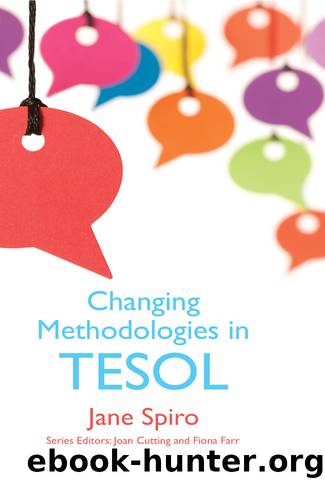Changing Methodologies in TESOL by Jane Spiro

Author:Jane Spiro
Language: eng
Format: epub
Publisher: Edinburgh University Press
â¢
Being exposed to examples of real spoken English helps to prepare learners for real-world communication.
â¢
Teachers and learners can also be researchers of spoken language, gathering examples of the way language is spoken in their real-world context.
Table 6.8 Analysing a conversation from <http://news.bbc.co.uk/1/hi/5188258.stm> (last accessed 24 January 2012)
Spoken English
What should the teacher notice?
A: I'm just . . .
B: You're leaving? (1)
A: No, no, no not yet. On this trade thingy (2) . . . (3) [indistinct] (4)
B: Yeah, I told that (5) to the man.
A: Are you planning to say that here (5) or not?
B: If you want me to.
A: Well, it's just that if the discussion
arises . . . (6)
B: I just want some movement.
A: Yeah. (7)
B: Yesterday we didn't see much movement . . .
A: No, no, (7) it may be that it's not, it may be that it's impossible. (8) (9)
1. Speakers often guess what other speakers are about to say, and complete utterances for one another
2. Vague language like âthingyâ is typical of spoken language.
3. Fragments of a sentence are sufficient to convey meaning or start a new topic.
4. We also fill silences with umms and ahhs, sometimes to show we haven't finished our comment and are searching for the next few words.
5. Speakers use words like âthatâ âhereâ, âover thereâ, âthis oneâ, which are clear to other speakers because they refer to knowledge shared by both about previous conversations, and the real world. These words which âpointâ to something are called deictics.
6. Speakers often interrupt one another so one utterance cuts into the middle of another, as Bush does here.
7. We tend to indicate that we are listening with encouraging interventions such as âyeahâ.
8. Repetition of words and phrases is also typical of speech.
9. Speakers often reformulate an utterance several times, as A does here: â it's not . . . then starts again . . . it may be that . . .
Download
This site does not store any files on its server. We only index and link to content provided by other sites. Please contact the content providers to delete copyright contents if any and email us, we'll remove relevant links or contents immediately.
Navigation and Map Reading by K Andrew(5111)
Spare by Prince Harry The Duke of Sussex(5074)
Tuesdays with Morrie by Mitch Albom(4695)
Cracking the GRE Premium Edition with 6 Practice Tests, 2015 (Graduate School Test Preparation) by Princeton Review(4227)
Machine Learning at Scale with H2O by Gregory Keys | David Whiting(4190)
Never by Ken Follett(3797)
Goodbye Paradise(3729)
What It Really Takes to Get Into Ivy League and Other Highly Selective Colleges by Hughes Chuck(3697)
Harry Potter and the Prisoner of Azkaban (Book 3) by J. K. Rowling(3304)
Fairy Tale by Stephen King(3221)
Pledged by Alexandra Robbins(3133)
Kick Ass in College: Highest Rated "How to Study in College" Book | 77 Ninja Study Skills Tips and Career Strategies | Motivational for College Students: A Guerrilla Guide to College Success by Fox Gunnar(3077)
A Dictionary of Sociology by Unknown(3031)
Sapiens and Homo Deus by Yuval Noah Harari(2987)
Reminders of Him: A Novel by Colleen Hoover(2952)
The Social Psychology of Inequality by Unknown(2941)
Graduate Admissions Essays, Fourth Edition: Write Your Way into the Graduate School of Your Choice (Graduate Admissions Essays: Write Your Way Into the) by Asher Donald(2877)
Will by Will Smith(2794)
Zero to Make by David Lang(2726)
